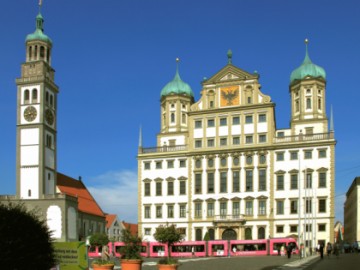Augsburg, city of canals and jewelers
In the medieval ages the merchant Augsburg was a symbol of prosperity of the burger Germany – and also, a symbol of kindness and peace. It was here that after the long Thirty Years’ war the first celebration in honour of reconciliation between the Catholics and the Lutherans took place. Today it is a town of jewelers, cakes and Bavarian beer. Augsburg is also often called the town of canals because it stands on two rivers – Lech and Wertach, and long time ago canals were dug to assist the work of mills and provide water to numerous weaving workshops. Today there are neither mills, no weavers here, but canals give the town a special charm.
Cafes, bars and restaurants in Augsburg
See all
Restaurants

Anna
Bar • Café • Catering
+49 821 4550780
Payment methods:

Augsburger Kahnfahrt
Restaurant • Biergarten
+49 821 35516
Payment methods:

Bayrisch Brau Pub
Restaurant • Brewery
Payment methods:

Charly Bräu
Steak House • Fast Food • Vegetarian restaurant
+49 821 36561
Payment methods:
All sights in AugsburgSee all
Landmarks in the city Augsburg

Fuggerei
Museums and Exhibitions • Other places

Basilica of St. Ulrich and St. Afra
Architectural Monuments

Augsburg town hall
Architectural Monuments

Mozart Museum
Museums and Exhibitions

Cathedral of Our Lady in Augsburg
Architectural Monuments

Perlachturm Tower
Architectural Monuments

Brecht museum
Museums and Exhibitions

Armory house
Museums and Exhibitions








 Museums and Exhibitions
Museums and Exhibitions
 Architectural Monuments
Architectural Monuments
 Other places
Other places